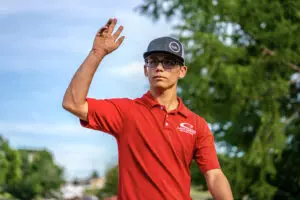Mastering Backhand and Forehand Throws
This article explores the differences between backhand and forehand disc golf throwing techniques, including grip, stance, advantages, disadvantages, and tips for beginners, with an emphasis on developing proficiency in both styles for adaptability on the course.
Understanding Backhand Technique
The backhand grip involves holding the disc with the thumb on top and the fingers underneath, employing a pulling motion for release. In executing a backhand throw, the optimal stance is essential for achieving balance and generating power. The wider range of motion and engagement of larger muscle groups in the backhand technique contribute to a stable and predictable flight path. However, some potential drawbacks of the backhand throw include limitations in certain situations or conditions. To maximize distance and flight control in backhand throws, it’s important to focus on proper technique and disc selection.
An example illustrating the backhand technique can be seen in a scenario where a disc golfer utilizes a backhand throw to navigate a wooded section of the course. The wider range of motion and engagement of larger muscle groups allow for the precise control needed to navigate through tight spaces with accuracy and stability.
Mastering Forehand Technique
The forehand grip involves placing the thumb on the inside rim and the fingers on the outside, utilizing a flicking motion to release the disc. Similar to the backhand technique, the stance for executing a forehand throw plays a crucial role in achieving balance and transferring power effectively. The specific advantages of the forehand (side arm) throw include its suitability for certain shot shapes or distances. However, there are potential challenges or limitations associated with the forehand technique in disc golf. Effective management of off-axis torque (OAT) and selecting the appropriate discs are key aspects of optimizing forehand throws.
For instance, in a situation where a disc golfer is faced with a narrow fairway with a dogleg to the right, a forehand throw can be advantageous. The flicking motion of the forehand technique allows the disc to navigate the dogleg with a controlled flight path, minimizing the risk of veering off course.
Comparing Backhand and Forehand Techniques
Comparing the range of motion, muscle engagement, wrist position, and spin generation between backhand and forehand throws provides valuable insights into the distinct characteristics of each technique. Additionally, understanding the variations in disc selection for backhand and forehand throws is essential for optimizing flight characteristics and stability. Developing proficiency in both throwing styles is beneficial for adaptability on the disc golf course, allowing players to effectively tackle diverse challenges and shot requirements.
An illustrative example of the importance of proficiency in both techniques can be seen in a scenario where a disc golfer encounters a course with a variety of hole designs, including open fairways and wooded areas. Proficiency in both backhand and forehand techniques enables the player to adapt to different shot requirements, optimizing their performance across various course layouts.
 Tips for Beginners
Tips for Beginners
For beginners looking to improve their backhand and forehand disc golf techniques, embracing user-friendly discs, prioritizing control with slower discs, and focusing on balance, footwork, and shot planning are crucial [3]. Additionally, mastering the short game through regular putting practice and seeking guidance from the disc golf community can greatly contribute to skill development.
As an example, beginners can greatly benefit from focusing on balance and footwork to improve the power and direction of their throws. By mastering these fundamental aspects early on, beginners can establish a solid foundation for their disc golf skills, setting the stage for further improvement in both backhand and forehand techniques.
Conclusion
In conclusion, exploring and practicing both backhand and forehand disc golf throwing techniques can significantly enhance players’ skills and adaptability on the course. Disc golfers are encouraged to embrace the distinct characteristics of each technique, aiming to develop proficiency in both styles to elevate their performance and enjoyment of the sport.




